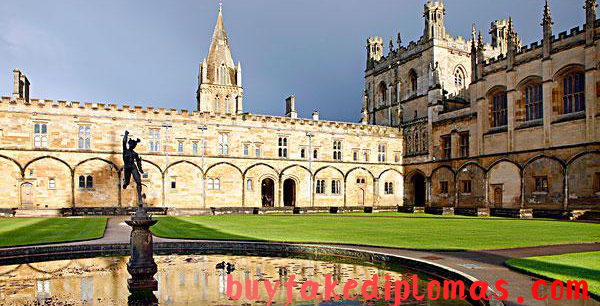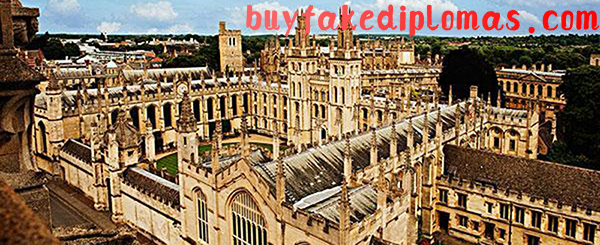
Oxford University has a long history, but no one can say for sure when it was founded. The founding story of Oxford University is quite remarkable. According to local people, Oxford University was founded in 1167, buy fake University of Oxford Diploma, when King Henry II of England ordered English theological students to study theology or religion at the University of Paris, so a group of religious scholars and students gradually gathered here, and gradually evolved into the prototype of the college. In other words, buy fake diploma, Oxford was founded because of the problem of “brain drain” in the early years. However, some sources suggest that its teaching activities date back to 1096, which would make Oxford’s history more than 900 years. There is no doubt that Oxford University is one of the earliest universities in living human history. Some historians say Merton College was the first college; It is also said that University College is the beginning of university. No matter which statement is correct, buy fake University of Oxford degree, buy fake University of Oxford transcript, it will not detract from the academic lofty status of today’s Oxford University which is composed of 46 colleges.
A long struggle between citizens and scholars ended in 1214 when Pope Pandolf, then the Catholic bishop of the area, granted the seminary special privileges, allowing scholars and students to live and study in the city. It was not until the second half of the 16th century that the tradition of all students living within the college was established. In the early days, all colleges admitted only male postgraduates. It was not until 1912 that Oxford University made three major changes: women were admitted, and Old Greek was no longer a compulsory subject. After 700 years of independence, Oxford University is finally willing to accept government subsidies, but the government still has no right to interfere in university affairs.
University of Oxford: Institution of the University
Oxford is composed of a central school (including school and department libraries, as well as science laboratories), 39 colleges, and 7 Permanent Private Halls (PPHs). These colleges are not just dormitories, but are essentially responsible for teaching undergraduate and graduate students. Some colleges only accept graduate students, while one college admits no students at all.
The Oxford College system emerged at the time of the birth of the University and gradually became a collection of independent institutions in the city of Oxford.
Similar to the organization of most other universities, Oxford is divided into different departments according to the subject matter. Departments usually play a major role in postgraduate teaching, offering lectures, courses and organizing examinations. Departments are also often research centers funded by outside organizations, including large research councils.

University of Oxford: Admission
Undergraduate admission is approved by independent colleges, where their students are taught by tutors and lectures and courses at the university. Graduate students’ offers are first determined by each department and then by the associated school.
Unlike America’s elite (mostly private) schools, Oxford (and Cambridge) are public institutions that cannot overtly display an “endowment preference”, which means that a child of wealthy parents will have an advantage over a child with no connection to Harvard.
The requirement that undergraduates be Anglican was repealed in 1871. Before 1920, knowledge of ancient Greece was a must. Before 1960, Latin was required. Women were not able to get an Oxford degree until after 1920.
Oxford University: Glory and Dreams
Less than 100 kilometers up the River Thames from London is the picturesque city of Oxford. Oxford was an important crossing on the Thames in the Middle Ages. The so-called Jin, ferry meaning also, the town is named. Oxford’s location in the centre of southern England made it a major overland route. Quaint, quiet and simple are the first impressions that Oxford leaves on visitors. The world-famous University of Oxford is located here.
Oxford University: The cradle of celebrity
In the British society, which values tradition and class consciousness, graduates of Oxford law and Cambridge still have a higher social status and more opportunities to jump the gate. People say, “An Oxford diploma in hand is enough to make the world proud.” It can be seen that Oxford University has a high reputation in the eyes of British people. Its influence extends far and wide, including in politics, the humanities and the arts. Of the 49 British prime ministers, 25 were Oxford-educated. Its famous alumni are many famous people from all over the world, such as former US President Bill Clinton. There are Professor Halley, the discoverer of Halley’s comet, the famous economist Adam Smith, the scientist Lord Wren who had a profound influence on British architecture, and the famous poets and writers Shelley, Eliot, Harding and Lewis. Caro (also a mathematician), famous Middle Eastern political historians Lawrence of Arabia, and the list goes on.

University of Oxford: Collegiate system
The organization of Oxford University is quite complex and difficult to understand. This is mainly because the word “university” has a different meaning to Oxfordians than we are used to. The British call it “The University of Oxford”, which fits the truth. On the map of Oxford, we cannot find a fixed boundary of the university campus, but we can see the different colleges in different districts. In Oxford, to ask: “Where is Oxford University?” No one can answer it. When the English mention Oxford, they should raise their head and look up, and solemnly recite “Ox-Ford”. The word O should be round and heavy to show respect, which is the respect for academia.
At present Oxford University is made up of 39 colleges and seven Permanent private halls, which are established by the Church. The oldest is said to be Merton College, founded in 1264, and the youngest, Wolfson College, founded in 1966, a full seven centuries apart. The name of the college may sound strange, but in fact many colleges are named by chance. Christ Church, for example, is a college because Oxford’s oldest cathedral is in the college; All Soul’s College honors the souls of the Hundred Years War dead; Oriel College, for its part, bought a house called “Oriel” (meaning Oriole) when it was just established. There is also Brasenose College, a name derived from the English word for “brass nose,” because the brass knocker on the college gate resembles a nose and is still used in the college dining room. The schools are also not divided by major, but over the course of their development, each school has gradually developed its own characteristics. Christ Church, for example, is known for its aristocratic atmosphere; Merton College has produced many poets; St Edmund Hall is particularly fond of recruiting athletes; Oriel College focuses on the training of priests; Magdalen College has many great rowers. These colleges are equal to each other, and students can study in any of them until graduation.
Except for the seven colleges, which are limited to postgraduate students, the remaining 32 colleges and the seven Permanent private Colleges all admit undergraduate students (or both). Some of these colleges are boys only (Oriel) or girls only (St. Hilda’s, St. Hugh’s and Somerville), but most are both. As far as the college itself is concerned, each has quite independent management power. The College sets its own rules, raises the necessary financial resources and enrolls students of its choice. However, any person wishing to study at the University of Oxford must also obtain the consent of the University department and college for admission. This is deemed to be a formal admission requirement and a special feature of Oxford and Cambridge. The biggest function of the college is to take care of students’ accommodation, arrange various sports and group social activities, and assign tutors to take care of students. Due to the different financial status of each college, some colleges are very rich, have a large space and good facilities or benefits, such as guest house, library and research room. The role of the university is mainly to represent the colleges, arrange lectures and seminars in the whole university, and issue diplomas. So in fact, the relationship between students and their colleges is much greater than that of universities.
The main function of the college is to provide accommodation and tutors. Therefore, each college has an area of specialization which limits the degree of study of the applicant. Because the faculty equipment of each college is different, the recruitment of students is different, the accommodation period is not the same. Nuffield College, for example, specialises in the social sciences. It only admits 25 graduate students a year. But once each graduate student is admitted, he/she is equipped with a research lab and library facilities.
When applying for a place at Oxford, there is a section on the application form that asks applicants to list four colleges in order of preference. Whether this order will be admitted. If the more reputable colleges are listed after the others, the chances of admission are greatly reduced. Therefore, before filling out the application form, you must read the Oxford University Profile in detail and apply to the colleges in which you specialize. It is better to contact the expert professors of the colleges in advance and send your research proposal together with the published articles. If you can win the favor of the professors of the colleges, then you are admitted to the university. Naturally, the professor will ask the Oxford Colleges Office to accept you as a graduate student. At the same time, this kind of good relationship between teachers and students will be more conducive to the smooth progress of future research work.

University of Oxford: Tutor system
The work of Oxford students is carried out in two main ways: the first is the arrangement of lectures, and the colleges provide candidates for tutors. Of course, faculty members from several colleges are also employed as university professors to teach courses on a particular subject for students from each college to choose from. When students apply for admission, the application documents are generally reviewed by professors in the relevant disciplines of each school. And one of the professors becomes the tutor for the student’s specialty. This is the most famous tutorial system in British education. The tutor meets with the student once a week during the semester. For each class, the student must prepare a research essay or essay in response to the book or problem assigned by the tutor. In the process of teacher-student discussion, students first read their own articles, and then the tutor or another student who participated in the discussion discussed and discussed the thesis. According to one professor, the spirit of the tutorial system is to train students to think logically and react on the spot. At the same time, for the 8-week intensive semester system of Oxford students, it is more necessary for the tutor to have a clear understanding of the students’ study at any time.
University of Oxford: Length of study and Degree
Basically, degrees above bachelor’s degree in the UK can be distinguished according to the way of further study. One is by courses obtained, which may include certificate, diploma and master’s degree. The other is by research, including master’s degree and doctor’s degree. The master’s degree program is one or two years long, and the more common degree names are MA and MSc. Oxford and Cambridge MA degrees are awarded to graduates who have paid a small certificate fee for a certain period of time (three years).
A research-based master’s degree requires at least two years of study, and a PhD degree requires at least three years of study. In other words, you need to be enrolled in school for at least three years before you can submit your thesis. For those who pursue a master’s degree and then pursue a PhD degree, the period of study for a master’s degree can often be combined. In addition, if a master’s degree candidate is satisfied by the supervising professor, he/she may apply for transfer to the doctoral program after one year of study. The first year of study may be added to his/her doctoral years. As for the research-oriented degree names, the more common ones are M.hil and Ph.D. (or D. Phil), while the research masters of Oxford University are called M. Litt. (Master of Letters). As for the Doctor of Letters (D. Litt.) and Doctor of Science (DSc) degrees, they are usually awarded to Senior Doctorates who have made outstanding contributions in various fields. Sometimes it is an honorary degree.
University of Oxford: Teaching Management
The total number of students at Oxford’s colleges is around 12,000, of which around 9,000 are undergraduate students, and there are 5,400 academic staff. The main administrative staff in the university are selected from Oxford’s own professors and researchers. The Chancellor is an honorary position, while the actual administrative work is presided over by the Dean.
Presidents are elected by each college in turn for a four-year term. A Convocation, composed of all Oxford graduates, elected each rector. The actual administrative supervision and suggestions were carried out by the Congregation. An 18-member executive Council (Hebdomadal Council) is elected and meets once a week to decide the direction of the school along with the middle school administration.
The head of discipline in the university is also selected by the colleges in turn. As an added bonus, they can receive all the books published by the Oxford Publishing Department during their term of office, and they can also wear a black sash on their academic robes for life to show their appreciation for their work. On the other hand, campus police officers, nicknamed “Bulldogs” by students, still wear their traditional top hats to carry out their duties in an old-fashioned fashion and report to the university’s chief of discipline.
Three quarters of Oxford’s current funding comes from the British government. The rest of the financial requirements come from the colleges and donations. Depending on the actual financial burden and the state of the deficit, colleges often ask students to share the amount, which is often as high as 1 to 2 thousand pounds. The finance department of the school was called the University Chest, because the early university chests kept their money in a small iron chest. To this day, Willington Square, the administrative center of the university, retains a small symbolic iron casket. Students only need to pay according to the amount set by the college, write a check and put it in the Pigeon hole, instead of going to the financial accounting department to pay, which is quite convenient.

Oxford University: Thinking of the school spirit
It is almost impossible to visit each of the 39 colleges and the seven permanent private colleges. Each college has its own glorious history, fabulous architectural relics, and interesting historical facts. The common impression when you first arrive at Oxford is that each college is like one of those shabby old temples in various parts of China, which gives you a feeling of loneliness and desolation upon entering. Each college is a cluster of dormitories, classrooms, laboratories, LABS, and offices. Students live together and study together here, which is completely like a medieval monastery, which also reflects the strong nostalgia of Oxford people.
There are still many colleges in Oxford which maintain the style of the monasteries. For example, in a restaurant with regular seating and a high table, no one is allowed to sit up unless they are a professor, Senior Associate Member or Visiting fellow. In addition, there are also Senior Common Room, Middle Common Room or Junior Common Room in the fellowship hall. Generally, graduate students or researchers cannot sit with professors or senior researchers, unless they get consent, they will be expelled. Some colleges have to wear black robes in class, and formal examinations, opening ceremonies or graduation ceremonies maintain the old rules of the early Middle Ages, which are quite complicated, which also sets off the division of social classes and the retention of traditional style in Britain.
Radcliffe Square, the centre of the university’s celebrations and arts, is the heart of the old town, far from the bustle of the main street. Nearby Brasenose Lane, a red-brick street with a few pedestrians and a canopy of green trees, is refreshing. St. Mary’s Church is located on the south side of the square, where the school’s main celebrations and concerts were held until the 17th century. On the west side of the square is Brasenose College, which was founded in 1509. The college is named for the bronze lion’s nose knocking on its gate. There is a royal blue sundial clock in the courtyard at the main entrance of the college, but because of England’s peculiar cloudy weather, you can not see the shadow of the sun on the clock many times a summer. Some people say: “Britain only climate, no weather” is not an exaggeration, often a day can see snow, rain, sun, that is very common.
At the western corner of the square is the 15th century Divinity School, which in its early days served as the university’s seminar room and is now the reading room of the University’s Bodleian Library. The University Library has a collection of more than 4 million volumes, which is now the second largest in the UK, after the British Library. The most valuable is the library, there are many famous articles, music manuscripts. The manuscripts are displayed in elaborate glass cases. However, when each visitor finished reading, the management immediately covered it with black flannelette, which showed their treasure and preservation of the ancient objects. The Sheldonian Theatre, the main venue for the university’s current celebrations, is located directly north of the square. Around the 17th century, due to the clergy of St. Mary’s Church, excessive protests were held in the church, affecting the church’s maintenance. In 1669, Archbishop Sheldonian, then president of the university, funded the construction of the theatre. Across the street from the theater is Blackwell Bookstore, the second largest bookstore in the world, where you can buy or mail order books from all over the world.
